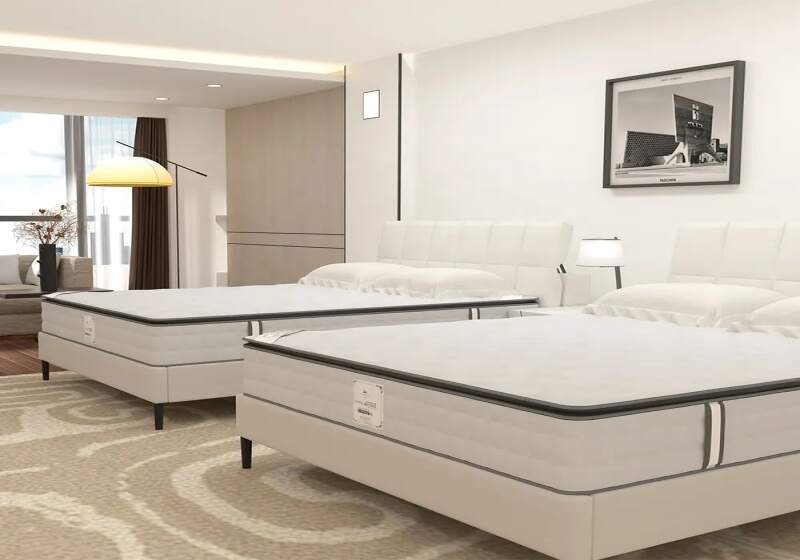Currency


When you stay at a good hotel, you probably notice how comfortable the bed feels—almost like it was made just for you. But have you ever wondered why hotel mattresses (often called hotel-quality mattresses or luxury hotel mattresses) seem to suit so many different sleepers?
The secret isn’t just high-end materials—it’s smart engineering. Hotels need beds that work for back sleepers, side sleepers, stomach sleepers, and combination sleepers, all while lasting for years under heavy use. Here’s how they do it—and how you can get the same comfort at home.
Hotel mattresses are rarely too soft or too firm. Instead, they use medium-firm support with a plush top layer—a combination that works for most people.
Pocket spring systems (common in best hotel mattresses) adjust to body weight, so a light side sleeper and a heavier back sleeper both get proper alignment.
High-density foam layers prevent sagging while keeping pressure off hips and shoulders.
This is why many hotels use hybrid mattresses—they combine springs for bounce and foam for contouring.
Ever notice that hotel beds don’t sag when you sit on the edge? That’s because they use reinforced borders (often with high-grade foam or extra coils).
1.Strong edges mean you can sleep near the side without rolling off.
2.Makes the bed feel larger—important for hotels where guests share beds.
If you want this at home, look for hotel-style mattresses with edge support.
Hotel mattresses stay cool because they use:
1.Breathable covers:Breathable covers are designed to allow air to pass through easily, which prevents heat and moisture from getting trapped near your body. Materials like Tencel and knit fabrics are particularly effective because they are both lightweight and moisture-wicking.
2.Cooling gel foam or airflow-friendly coils:Traditional memory foam tends to trap heat. To fix this, hotel mattresses use gel-infused foams or open coil systems that actively prevent heat buildup.
This is why luxury hotel mattresses rarely feel stuffy—even in warm climates.
A hotel mattress gets used every single night, so it must last 5-10 years without sagging. They achieve this with:
1.High-density foams:High-density foam offers durable support and long-lasting comfort. The density (measured in pounds per cubic foot) determines how well the foam can resist sagging over time.
2.Tightly coiled springs:Springs (or coils) provide the core support system in many hotel mattresses. A higher gauge number means thinner coils, but more coils per mattress—resulting in more precise support and greater durability.
3.Reinforced stitching to prevent seams from splitting:Reinforced stitching strengthens the seams and edges of the mattress to prevent splitting, fraying, or edge collapse. This stitching is often used in both the fabric encasement and pillow-top layers.
If you want a mattress that stays comfortable for years, check the mattress durability ratings before buying.
Hotels need beds where movement doesn’t transfer—so if one person turns, the other doesn’t feel it. They achieve this with two materials.
1.Individually pocket coils:Unlike traditional connected coil systems, where all springs are tied together, individually pocket coils work independently. Each coil compresses on its own, without pulling the others with it.
2.Memory foam or latex layers to dampen vibrations:Memory foam and latex are known for their ability to absorb and isolate movement. These materials are commonly used as comfort layers on top of the coil base in hybrid hotel mattresses.
This is why hotel mattresses for couples often use hybrid designs.
If you want a bed that feels like a 5-star hotel mattress, look for:
Hybrid construction (springs + foam):A hybrid mattress combines the supportive strength of coils with the pressure-relieving comfort of foam. Hotels favor this construction because it balances comfort and durability—two must-haves for guest satisfaction.
Medium-firm feel:Medium-firm is considered the “universal comfort zone” that suits the majority of people. It avoids being too soft (which can cause sagging and back pain) or too firm.
Strong edge support (no sinkage when sitting):Guests often sit on the edge of the bed—while getting dressed, putting on shoes, or simply resting. Weak edges cause sagging and reduce usable sleep surface. So hotels prefer mattresses with reinforced edges.
Breathable materials (cooling cover & airflow layers):Hotels want their beds to feel cool, dry, and fresh, no matter the climate or guest body type. Breathable materials—including gel-infused foam, open-cell structures, and cooling covers—help regulate temperature.
Motion isolation (important for couples):In hotels, guests may be sleeping alone or with a partner. A mattress that transfers too much motion can disturb sleep when one person tosses or turns.
LEIZI mattresses are dedicated to solving customers' sleep problems. We focus on providing customers with high-quality products in terms of material, quality, production, and service. LEIZI hotel mattresses are popular worldwide. If you have a need for hotel mattresses, please come to our factory to experience them. We will provide you with the most cost-effective mattresses.
Hotels invest in mattresses that work for all sleeping styles because their business depends on guest satisfaction. The best hotel mattresses aren’t just soft—they’re intelligently designed to support, cool, and last.
If you’ve been struggling to find the right mattress, a hotel-style bed might be the solution. Look for the features above, and you’ll get that "hotel comfort" at home.
They’re built for comfort and durability using a mix of premium materials, balanced firmness, and often include extra layers like pillow tops. Plus, they’re well maintained and used with high-end bedding.
Most are replaced every 5–7 years, though high-end mattresses can last longer with proper care.
Yes! Many hotel brands sell their signature mattresses online.
Look for a hybrid mattress with a plush or pillow top and zoned support to reduce pressure on shoulders and hips.
خطأ في تنسيق البريد الإلكتروني
emailCannotEmpty
emailDoesExist
pwdLetterLimtTip
inconsistentPwd
pwdLetterLimtTip
inconsistentPwd